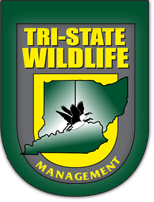Tri-State Wildlife Management – Protecting You, Your Property, and Your Investment
Starlings are found throughout the United States. They are commonly found around open woodlands, fields, lawns, parks, city buildings, and other structures. Starlings primarily feed on seeds, grains, fruits and insects. Insects total about one-half of their overall diet. They will also feed on garbage. Starlings commonly nest in soffits and cavities in buildings. Nesting will typically occur during the spring, although a second clutch of eggs may be laid before the end of summer. Starling droppings are hazardous to humans and buildings. Not only do these droppings accelerate the deterioration of buildings, cause unsightly damage and high maintenance costs, but also can spread diseases to humans and animals. In the Ohio Valley, large outbreaks of histoplasmosis have historically occurred due to large starling population.
Identification – The starling was introduced from Europe in the 19th century. Starlings are well adapted to living in North America where they have access to an abundance of food and nesting sites. The starling is a dark, chunky, muscular bird. It is distinguished from other blackbirds by its short tail and its longer, slender bill. Starling’s plumage varies depending on the season. In winter, the bird displays a highly speckled iridescent coat and dark bill. In summer, the bird’s coat dulls and has far fewer speckles. Starlings are very aggressive and will drive native birds out of their territory. Starlings are well noted for their flocking habits. They often gather in the tens of thousands, creating a nuisance when roosting.
Cycles – Not a true migrating bird, starlings may move from rural trees to warm structures in winter. The daily cycle is one of leaving the nest or roost at sunrise to travel up to sixty miles to feeding areas before returning for the evening. They disperse to mate in the spring. After mating season, they will often coalesce into huge flocks with defined feeding and roosting areas.
Breeding – Starlings have two broods per year with four to five eggs to a brood. They average eight offspring a year. The eggs are white, pale blue or green-white. Incubation of the eggs takes twelve days. The fledglings leave the nest after 25 days. The young leave to join other juveniles and form huge flocks that move on to other territories.
Damage – Starlings can be a nuisance in both urban and rural areas due to their nesting, eating and roosting habits. When the bird is in its flocking phase, thousands of starlings often overwhelm structures and trees. Large scale buildup of feces from these flocks can lead to structural damage. The uric acid in the feces can corrode stone, metal and masonry. Gutters and drainage pipes clogged with starling nests often backup, causing extensive water damage. The bacteria, fungal agents and parasites in the feces also pose a health risk.
The starling is a nesting bird. Their nests are in enclosed areas with at least a 1 ½” opening. Nests can be found in soffits, vents, church steeples, parking garages, and insulated walls in barns and warehouses. Due to their bullying nature, they will take any suitable site, evicting any previous owner. They sometimes watch other birds build a complete nest before forcing them to leave.
Roosting Control – Starling roosting habits may be modified using a combination of scare campaign equipment including strategically placed propane cannons and/or sophisticated audio systems. Netting, electrical shock systems, cables, and green lasers are also some common tools used by Tri-State Wildlife Management to deter and move populations of birds.
Nesting Control – Starling nesting habits can be successfully controlled by using a combination of stealth netting, electrical shock systems and bird slides modified to fit any circumstance.
Health and Safety – Starling droppings create a health and safety concern to anybody coming into direct contact with their fecal materials. The droppings, due to their high nutrient content, are a breeding medium for numerous insects and fungus. Due to the availability of consistent moisture and drying, droppings will develop fungal spores which can expose workers to disease. Mycoses histoplasmosis is the most common disease associated with starling droppings. These fungal organisms are ubiquitous in the environment and exposure to them is impossible to avoid. However, most humans are resistant to the amounts they encounter during normal activities. The risk of contracting these fungal infections is greatly increased by certain predisposing conditions such as an immunocompromised state (e.g., HIV infection, immunosuppressing medication, cancer, antibiotic therapy, surgical trauma, skin injury, and chronic disease etc.).
What is Histoplasmosis? Histoplasmosis is a disease caused by the fungus Hstoplasma capsulatum. This fungus grows on bird or bat droppings or in soil contaminated with bird or bat droppings. Histoplasmosis is found throughout the world. The Ohio and Mississippi river valleys are areas in the U.S. where this organism is more prevalent. Infection occurs from breathing in the airborne spores after contaminated material has been disturbed. Approximately 80% of the population living in areas like the Ohio River valley (which includes Kentucky) will skin-test positive for histoplasmosis exposure. It is recommended by the National Institute for Occupational Safety and Health (NIOSH) to avoid areas such as bird roosts that may harbor the fungus.
To have your starling problem taken care of sooner rather than later, call us today! Put our experience and expertise to work for you!
Tri-State Wildlife Management is fully insured, and we stand behind all of our work.










